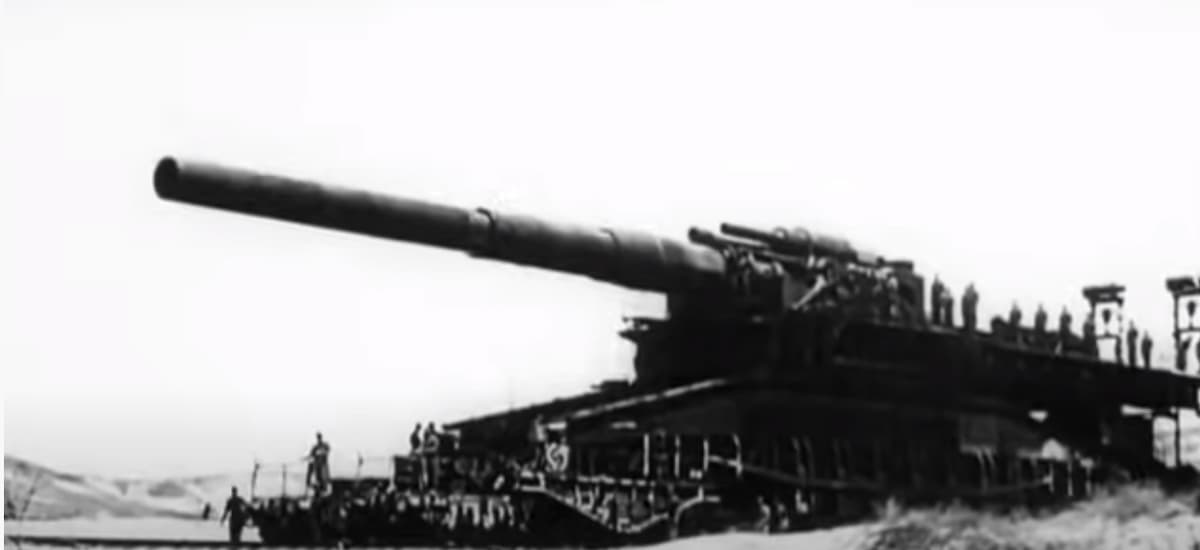The Wepon that could fire a 4 tonne bullet
Hitler’s enormous gun, known as Schwerer Gustav, was a terrifying weapon of war. Cannons of ever-increasing size and calibre were a distinguishing characteristic of Second World War artillery. Another example was the 914 mm Little David, which was built for the American army. At the end of WWII, it was supposed to be used to attack Japanese bunkers. This was the world’s most giant mortar, but it was never deployed in combat. Before it could be deployed, the Japanese surrendered.
Birth of the Schwerer Gustav
This remarkable weapon dates back to 1935, when it was developed as part of a Wehrmacht study into the types of weapons required to breach France’s newly built defences. Schwerer Gustav was developed before World War II when Hitler ordered its creation as a prelude to the invasion of France.
Its purpose was to assist the German army in breaking through the Maginot Line. Although it was not built in time for the invasion of France, it participated in some battles throughout the war.

Railway Guns
This superb weapon is a railway cannon; its sheer size has limited its mobility between deployments, making it impossible to transport the disabled components. That’s why the gun was delivered in parts and assembled on the spot.
The gun is disassembled into five parts. The breach ring and block, the barrel in two sections, the barrel jacket and cradle, and the trunnions were all on the list. For mobility between fighting areas, mounting was separated lengthwise. Except for the bogies, which could be transported on their wheels, all components were transported on customized flat wagons.
Testing of Schwerer Gustav
The weapon’s construction turned out to be far more complicated than expected. Forging the barrels was a particularly challenging task. The agreed-upon deadline passed without the gun being delivered.
The barrel was ultimately ready near the end of 1940, and it was test-fired in 1941. The carriage for the gun was likewise prepared for deployment. The entire assembly was transported to the Rugernward range on the Baltic coast, where Hitler himself watched the final body and test shooting. Gustav presented the weapon to the German war effort after it was finished and was named after him.
Deploying the Schwerer Gustav
Gustav eventually went to battle in July 1942, during the siege of Sevastopol. The assembly of the gun took a total of three weeks and employed 1,420 personnel. The weapon was 43 metres long, 7 metres wide, the barrel’s axis was just 7.5 metres from the railway when fully completed.
The weapon required a specific four-track section to be laid for it to be installed. The bogies were accommodated on the inner tracks, while the outer tracks were required for the gun’s actual installation.
Schwerer Gustav Firing Range
After the hard work in the assembling of the weapon, the gun was ready for action. Gustav launched an attack on Sevastopol’s Soviet fortifications, launching 4.7-tonne high explosive shells from a distance of 47 kilometres deep within the besieged city. The gun has a range of 37 kilometres and can fire 7-tonne concrete penetrating projectiles.
One of these shells was said to have penetrated 100 feet into the ground before exploding in an underground weapons storage facility. Approximately fifty of their shells were fired into the city during the siege.
Gustav appears to have faded from view after the siege. It was supposed to be deployed during the siege of Leningrad, but the Russians fought off the Germans before the weapon could be built.
The only other time Gustav was reported to have been used was in 1944 when it launched 30 shells into Warsaw during an attempted insurrection, but this may not be accurate. According to conflicting sources, the insurrection was put down before the cannon was deployed.
Loading the Gun
Without something to shoot, a gun of any type is useless, but it was not the case with the Schwerer Gustav. She could hold two different types of ammo, such as Armor penetrating and high explosive. These shells were giant in their own right.
The high explosive option was roughly 4.7 metric tons in weight. They were let go with a muzzle velocity of 820 m/s and a maximum range of 48 kilometres. On impact, these shells might create a crater 9.1 metres wide and 9.1 metres deep, containing roughly 700 kg of explosive.
The Final Word
The weapon had cost a staggering ten million German marks, with the cost of ammo lost to history. It’s unknown whether the present world would be different if the gun had been ready at the start of the war. Its impact and final fate would most likely remain unchanged due to its ungainly character. The German war machine, unsurprisingly, shifted its attention to other new weaponry.
The weapon was impressive in its unrealized power, but it was doomed in the end. Its fate did not correspond to its devastating potential. The Schwerer Gustav has gone down in history as a much-anticipated but ultimately unsatisfactory military weapon.
If you want to know more about guns, read about the US Gun Laws By State.